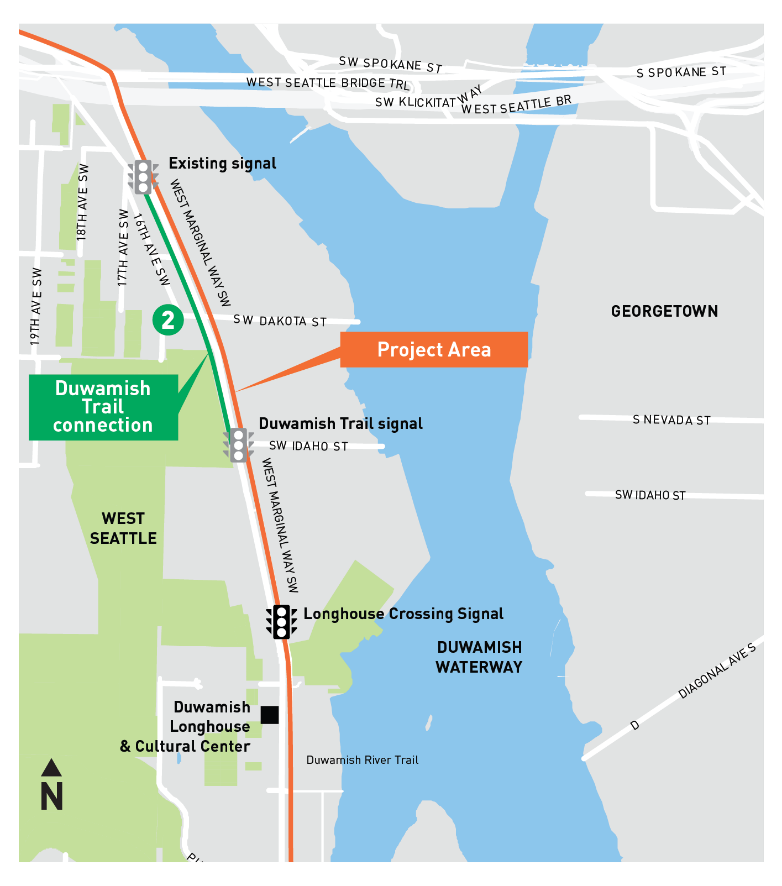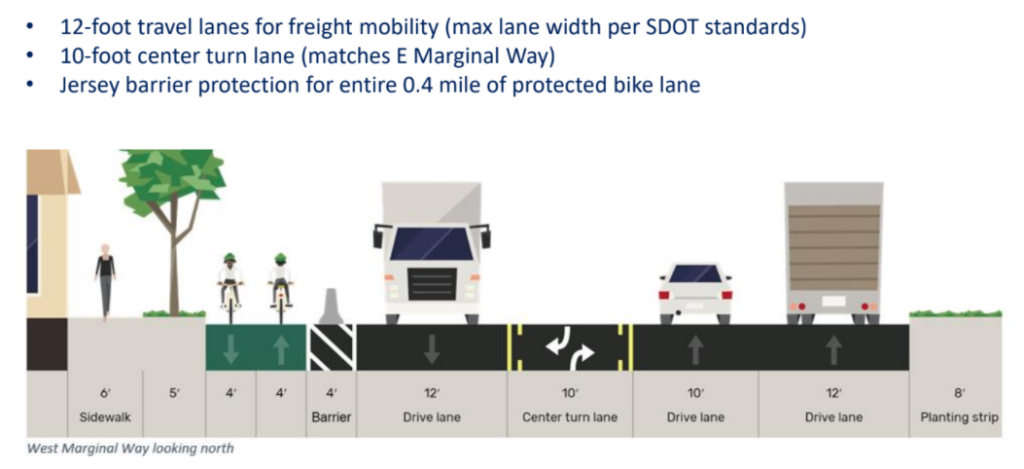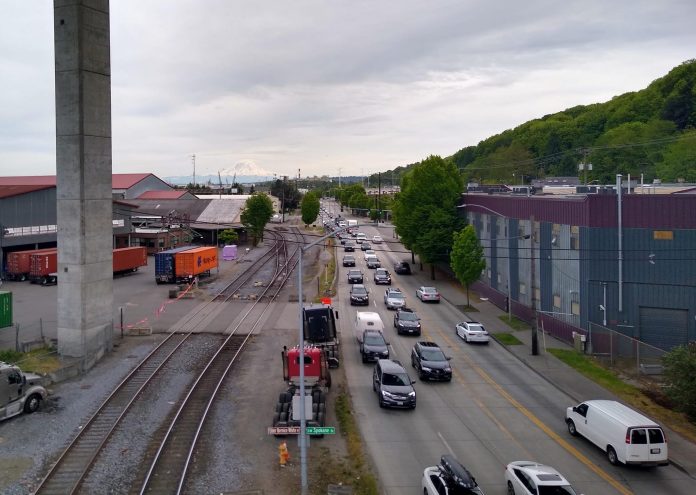As the Seattle Department of Transportation (SDOT) moves forward with plans to repair the West Seattle Bridge, it is working to assemble full funding to pay for the $175 million estimated cost for the entire West Seattle Bridge repair program, which includes the repair itself, repairs to the lower Spokane Street swing bridge, and traffic impact mitigation from the high bridge’s current closure. The vast majority of that funding will come from City sources, but this week the Port of Seattle moved forward with providing $9 million to the program.
Like many projects that the Port of Seattle has provided funding for, including the $15 million it handed over for the completion of the South Lander Street overpass in 2017, an agreement has been reached that lays out the terms, in the form of a Memorandum of Understanding (MOU). The MOU includes a laundry list of items that the City will work with the Port on in exchange for the funding, including access to the low bridge, expedited permitting on Terminal 5. The MOU also has the potential to open back up an issue that SDOT and some freight advocates (including the Port) have been wrangling over for over a year now: connecting the Duwamish River Trail by reallocating a lane on West Marginal Way SW.

Tucked inside the document is a section that reads, “The City will construct Duwamish Trail bike lanes on West Marginal Way after the [West Seattle High Bridge] reopens. The City will work with the Port, [Northwest Seaport Alliance] and all of the industrial users of the major truck route to together to ensure the design will maximize safety for all modes and minimize freight impacts on this Major Truck Street.” The details of the agreement were first reported on by the West Seattle Blog.
The City already announced that it had made the decision, after months of process, to delay the construction of the 0.4-mile protected bike lane until after the high bridge reopens next year. But giving the Port of Seattle more control over the design of the facility itself could spell trouble for the project. Port Commissioner Peter Steinbrueck has been a vocal critical of the current design, which utilizes the fact that West Marginal Way slims down to one southbound lane to provide better sightlines for people crossing at the Duwamish Longhouse and would only extend that lane reduction further north.
In a set of questions to SDOT’s Heather Marx, who is in charge of the West Seattle bridge repair program, sent after the announcement of the delay to 2022, Commissioner Steinbrueck questioned the level of environmental review that SDOT had conducted on the project, asked why additional time was not being spent on “community and stakeholder engagement,” and pressed Marx for details on discarded alternatives. The primary alternative that has been discussed is expanding the existing sidewalk next to where the proposed bike lane would go. Marx notes that this option would cost $2.5 million, require the removal of 38 mature trees along the street and the relocation of ten City Light poles, and rebuilding of ten driveways. SDOT’s proposed design, by contrast, would cost $400,000.

Steinbrueck also brought up a left-field alternative, building a trail behind the Seattle Parks and Recreation facility connecting north to 16th Avenue SW. Marx notes that option would be “prohibitively expensive requiring private property acquisition and substantial slope stabilization.” The concept of alternatives, no matter how expensive, could provide further avenues for the Port to pursue as they provide input into the design, per the new MOU.
This past March, Port of Seattle Executive Director Steve Metruck and Northwest Seaport Alliance CEO John Wolfe wrote a joint letter to SDOT Director Sam Zimbabwe. The letter refers to a “seemingly rushed decision-making process” to create a safe facility on West Marginal Way as part of West Seattle Bridge closure impact mitigation, asking for the installation of the bike lane to be postponed until after the high bridge reopens and Terminal 5 operations are restarted in early 2022. The letter also echoed concerns raised by other freight advocates, particularly some members of the Seattle Freight Advisory Board, about taking away space on a Major Truck Street, the street’s freight designation, and a route for oversized freight traffic.
“As you are aware, according to the Complete Streets Ordinance, this [street designation] means that freight has priority in this corridor, other modes can be accommodated if there is no material impact on truck mobility and access to businesses.” The project having “no material impact” is of course subjective, even as SDOT has said that the average impact to vehicles using the street would be ten seconds with the bike lane installed.
It’s still unclear how much leverage the Port will seek to take advantage of on this project. The Seattle Freight Advisory Board, or at least a previous iteration of it (with most positions on the board currently vacant), has taken a more extreme position on West Marginal Way than we have so far seen from the Port, asking for the safety improvements at the Duwamish Longhouse to be removed so that West Marginal Way SW can be “restored as a five-lane facility.” So far, SDOT has not entertained the possibility and has stuck by improvements which include a signalized pedestrian crossing at the Duwamish Longhouse. But it is worth noting that the Seattle Freight Advisory Board retains a representative of the Port of Seattle as a member who is not subject to term limits, currently Geri Poor, the Port’s Regional Transportation Manager.
While it’s unlikely the City and the Port would end up in litigation over the design of a protected bike lane, the force and effect of the MOU could change the dynamic between the two entities. Ahead of the unanimous vote at the Port Commission to approve the MOU this week, Port of Seattle Deputy General Counsel Tom Tanaka told the Port Commission that he had “no qualms” about the language in the MOU being legally enforceable.
With approximately another year before SDOT is set to make changes to Marginal Way, there’s a lot of time for the project to change. It would be really unfortunate for Seattle to have traded finding funds to repair the West Seattle Bridge for a step backward on making a long-awaited connection in the city’s bicycle network.
Ryan Packer has been writing for The Urbanist since 2015, and currently reports full-time as Contributing Editor. Their beats are transportation, land use, public space, traffic safety, and obscure community meetings. Packer has also reported for other regional outlets including BikePortland, Seattle Met, and PubliCola. They live in the Capitol Hill neighborhood of Seattle.


